
The Princess Alexandra Hospital (PAH) is a major Australian teaching hospital of the University of Queensland, located in Brisbane, Queensland. It is a tertiary level teaching hospital with all major medical and surgical specialities onsite except for obstetrics, gynaecology, paediatrics, and medical genetics. It has a catchment population of 1.6 million people with 1038 beds and 5,800 full-time equivalent staff. In 2005, the hospital received Magnet Recognition.

Woolloongabba is a suburb in the City of Brisbane, Queensland, Australia. In the 2016 census, Woolloongabba had a population of 5,631 people.

Diamantina, Lady Bowen, was a noble from the formerly Venetian Ionian Islands who became the wife of Sir George Bowen, the first Governor of Queensland.

The Park Centre for Mental Health is a heritage-listed psychiatric hospital at 60 Grindle Road, Wacol, City of Brisbane, Queensland, Australia. It is one of the largest psychiatric hospitals in Australia. The hospital provides a range of mental health services, including extended inpatient care, mental health research, education and a high security psychiatric unit. It was designed by Kersey Cannan and built from 1866 to 1923. It is also known as Goodna Hospital for the Insane, Goodna Mental Hospital, Woogaroo Lunatic Asylum, and Wolston Park Hospital Complex. It was added to the Queensland Heritage Register on 21 October 1992.

The Oregon State Tuberculosis Hospital was a tuberculosis sanatorium in Salem, Oregon, United States. Established in 1905, it was the first public tuberculosis sanatorium on the West Coast. The main hospital building, constructed in 1894, had formerly housed the Oregon State Deaf-Mute School. After its conversion into the state tuberculosis hospital, multiple cottages and additional buildings were constructed on the property. The hospital remained in operation until 1969, when it was purchased by Corban University.

Lady Bowen Hospital is a heritage-listed former maternity hospital and now social housing and office complex at 497–535 Wickham Terrace, Spring Hill, City of Brisbane, Queensland, Australia. It was designed by John H. Buckeridge and built from 1889 to 1890 by John Quinn. It was also known as Brisbane Lying-In Hospital and the Lady Bowen Hostel. It was added to the Queensland Heritage Register on 23 April 1999. The complex consists of the former hospital and nurses' quarters buildings; a third building which had been contained in the heritage listing was demolished c. 2005–2008.

The Translational Research Institute (TRI) is Australia's first translational medical research institute dedicated to translating scientific discoveries into applications for medical practice.

Toowoomba Hospital is a heritage-listed hospital at Pechey Street, Toowoomba, Toowoomba Region, Queensland, Australia. It was built from c. 1880 to c. 1927. It is also known as Toowoomba Base Hospital. It was added to the Queensland Heritage Register on 28 July 2000.
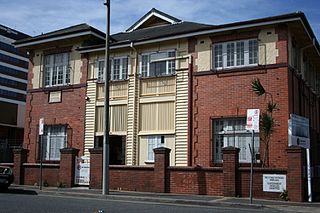
Fortitude Valley Child Health Centre is a heritage-listed clinic at 112 Alfred Street, Fortitude Valley, Queensland, Australia. It was designed by Cecil James Virgo. It is also known as Fortitude Valley Baby Clinic & Nurse Training Centre. It was added to the Queensland Heritage Register on 12 August 2011.
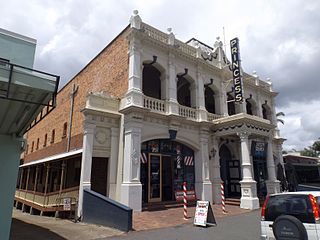
Princess Theatre is a heritage-listed theatre at 8 Annerley Road, Woolloongabba, Queensland, Australia. It was designed by architect John Beauchamp Nicholson and built in 1888. It is also known as South Brisbane Public Hall and Boggo Road Theatre. It was added to the Queensland Heritage Register on 21 October 1992.

Woolloongaba Post Office is a heritage-listed former post office at 765 Stanley Street, Woolloongabba, City of Brisbane, Queensland, Australia. It was designed by Thomas Pye and built in 1905 by Thomas Rees. It is also known as Woolloongabba Post & Telegraph Office. It was added to the Queensland Heritage Register on 24 January 2003.

Musgrave House is a heritage-listed sanatorium at 8 Allpass Parade, Shorncliffe, City of Brisbane, Queensland, Australia. It was designed by Richard Gailey and built from 1884 to 1920s. It is also known as Lady Musgrave Sanitorium for Sick Children. It was added to the Queensland Heritage Register on 22 October 1999.

The Royal Brisbane Hospital Nurses' Homes are heritage-listed accommodation for nurses at the Royal Brisbane Hospital, Herston Road, Herston, City of Brisbane, Queensland, Australia. It was built from 1896 to 1939. It includes the Lady Lamington Nurses' Home and Nurses' Homes Blocks 1 & 2. It was added to the Queensland Heritage Register on 21 October 1992.

Rosemount Hospital is a heritage-listed public hospital and health precinct in the suburb of Windsor in Brisbane, Queensland, Australia. Rosemount Hospital is co-located on the broader but synonymous Rosemount Campus, which houses a number of community health services provided by Metro North Health, the local health district within Queensland Health. It is also known as Rosemount, Rosemount Military Hospital, and Rosemount Repatriation General Hospital. It was built between the 1850s and 1940s, and was added to the Queensland Heritage Register on 24 September 1999.
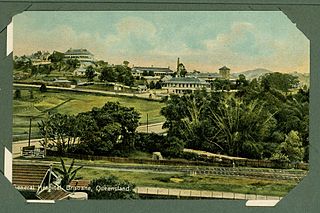
Brisbane General Hospital Precinct is a heritage-listed hospital precinct at 40 Bowen Bridge Road, Herston, City of Brisbane, Queensland, Australia. It was built from 1875 to 1941. It includes six historic buildings associated with the Royal Brisbane and Women's Hospital and the former Royal Children's Hospital, as well as aspects of their grounds and landscaping. It was added to the Queensland Heritage Register on 28 March 2003. A number of buildings in the precinct, in particular the Lady Lamington Nurses Home, will be redeveloped as part of the Herston Quarter development.

Maryborough Base Hospital is a heritage-listed hospital at Walker Street, Maryborough, Fraser Coast Region, Queensland, Australia. It was designed by Queensland Colonial Architect John James Clark and built from 1887 by Robert Taylor. It is also known as Maryborough General Hospital. It was added to the Queensland Heritage Register on 2 February 1998.

Springsure Hospital Museum is a heritage-listed former public hospital and now a museum at 13 Woodbine Street, Springsure, Central Highlands Region, Queensland, Australia. It was built from 1868 to 1879. It is also known as Springsure Hospital. It was added to the Queensland Heritage Register on 21 October 1992.
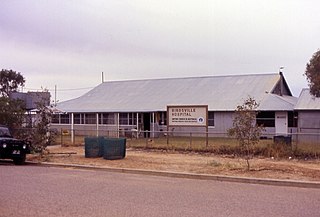
Australian Inland Mission Hospital is a heritage-listed former hospital at Adelaide Street, Birdsville, Shire of Diamantina, Queensland, Australia. It was built from 1952 to 1953 by Ben Hargreaves. It was added to the Queensland Heritage Register on 17 July 2008.
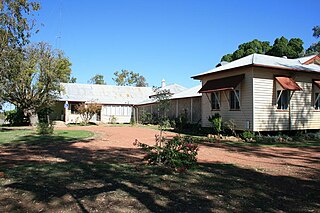
Old Isisford District Hospital is a heritage-listed former public hospital at 6 St Agnes Street, Isisford, Longreach Region, Queensland, Australia. It was designed by Queensland Department of Public Works and built from 1914 to 1918. It is also known as Isisford District Hospital (former). It was added to the Queensland Heritage Register on 9 September 2014.

Dutton Park State School is a heritage-listed government primary school at 112 Annerley Road, Dutton Park, City of Brisbane, Queensland, Australia. It was built from 1916 to 1934. It was also known as Woolloongabba State School, Woolloongabba Boys State School, and Dutton Park Boys State School. It was added to the Queensland Heritage Register on 30 November 2018.























